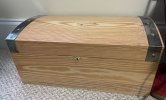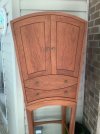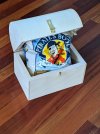I am working on a small box (for a Grandson) 14" x 25" x 12" high. Wanting to loosely resemble a treasure chest. I was thinking of a curved lid but failed miserably using angle rip cuts on plywood slats (aka coopering) to result in the curve I was looking for!
I prefer to have the lid around 1/2" thick. Are there any tricks to getting the ply to bend to the arch I am looking for using the kerf cutting bending process? (The lid body will sit in a 1/2" rebate in the sides.)
Any input/tricks would be appreciated.
Thanks,
Wayne
I prefer to have the lid around 1/2" thick. Are there any tricks to getting the ply to bend to the arch I am looking for using the kerf cutting bending process? (The lid body will sit in a 1/2" rebate in the sides.)
Any input/tricks would be appreciated.
Thanks,
Wayne
Last edited:



